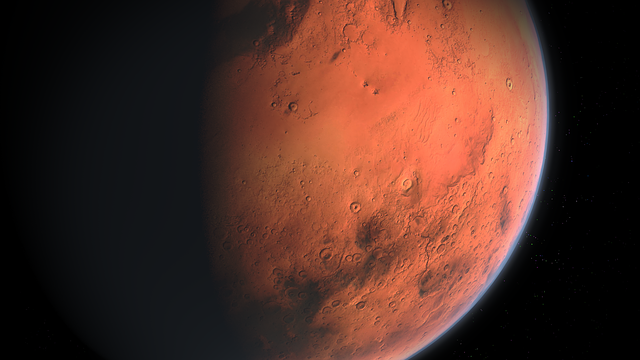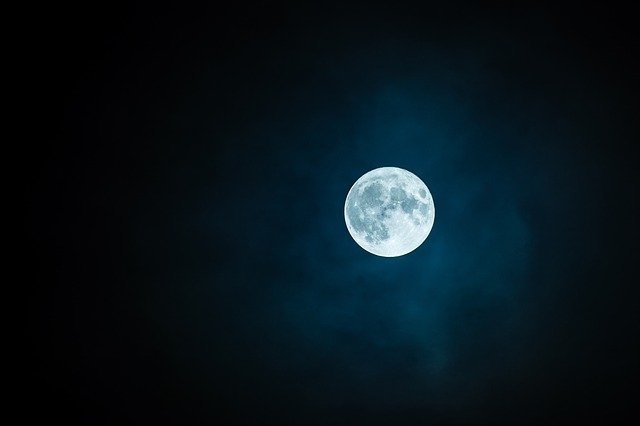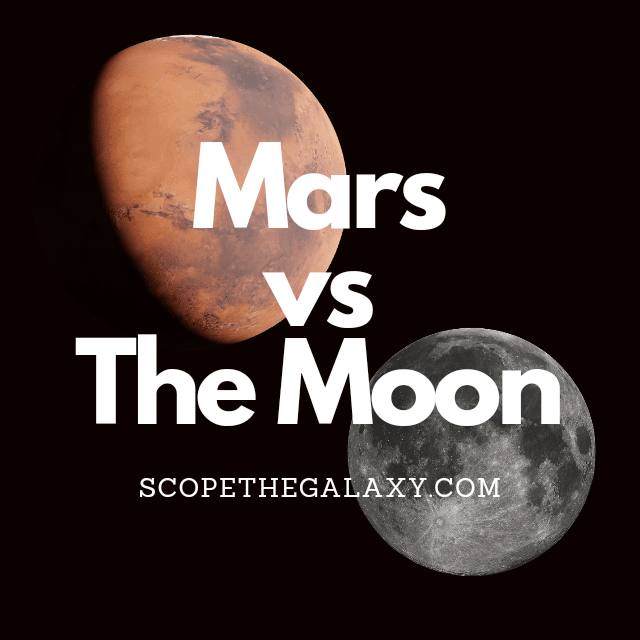*This post may contain affiliate links. This means we may make a commission if you purchase an item using one of our links*
The main differences between Mars and the Moon is that Mars is the 4th farthest planet from the Sun whilst the Moon is a natural satellite that orbits Earth, Mars is bigger with a diameter of 6,779km as opposed to the Moon’s 3,474.8km, Mars has 2 Moons orbiting whilst the Moon has no object orbiting it and the Moon is dark gray whilst Mars is red in color.
There are variety of other differences between these two celestial bodies so, continue reading if you want a more thorough breakdown of the similarities and differences between Mars and the Moon.
What Is The Planet Mars?
Table of Contents

Mars, also known as the red planet, is the celestial object that’s the front runner in our entire solar system to become a possible new home for us if terraformed. It is also the 4th farthest planet from the Sun and is one of 4 main line
terrestrial planets (not including Pluto) in our solar system.
This means that one year on Mars will take roughly 687 Earth days and a day on Mars is roughly the same as Earth at 24 hours and 37 minutes. It’s axial tilt is also very similar to that of Earth where it is positioned around 25 degrees to the right.
It may not be the largest terrestrial world in our solar system as its diameter is only 6,779km but, it does have the most moons amongst the normal terrestrial planet where two, namely Deimos and Phobos, are currently orbiting the red planet.
Like Earth and the other terrestrial worlds, Mars does have an atmosphere, certainly more visible than that on Mercury but, when compared to Earth’s it is merely 1% of its volume.
As a result it is more susceptible to larger debris striking its surface and is unable to trap in too much heat either. This is why it’s on the colder side with a temperature of around -65 degrees Celsius on average. On the contrary its core is significantly hotter at 1,350 degrees Celsius.
Mars is probably the most explored planet outside of our own, with a multitude of rovers like Sojourner (1997–1997), Opportunity (2004–2018), Spirit (2004–2010), Curiosity (2012–), and Perseverance (2021–) that have landed on the Martian soil to explore it.
Billionaires like Elon Musk and even Jeff Bezos are trying for an opportunity to genuinely have astronauts land on the Martian soil, possibly as early as 2029 so, Mars clearly has a lot interested in its terrain, as a potential substitute for Earth in the future.
What Is The Moon?

The moon is the gray celestial being that orbits our Earth. It is also tidally locked to Earth meaning that we only see one side of it at any time in our sky.
It takes the moon roughly 27 days to complete an orbit around Earth, which it does it in an elliptical pattern. The Moon’s axial tilt is very straight at 1.5 degrees. As a resut of the tidally locked status along with the effects that Earth has on Its general rotational patterns, it takes the Moon roughly 29.5 days to complete a day.
In regards to its temperature, it fluctuates where it can be really hot at 127 degrees Celsius when the Sun is shining on it and to -173 degrees in areas where the Sun does not strike it. It’s core on the other hand is far hotter ranging between 1,327 to 1,427 degrees Celsius.
This is as a result of the lunar entity’s extremely thin to practically non-existent atmosphere, which not only results in these massive temeprature shifts bu,t is also the reason why it has over 100,000 craters on its surface.
Speaking of the Moon’s surface, the entity is mostly made of rocks, iron, magnesium just like most of the other moons and terrestrial based planets in our solar system.
It is among the bigger moons in our solar system with a diameter of 3,474.8km and a mass of 7.35 × 10^22 kg, which actually places it fifth amongst all moons in our solar system and would also make it bigger than the dwarf planet pluto.
Despite all the advancements in technology, the last time a manned mission was made to the Moon was on the Apollo 17 way back in Decemeber 1972 and no further missons have been done since, possibly as result of the polictial agendas behind the numerous countries vying for oppurtunties that we don’t know of.
Similarities Between Mars and The Moon
Mars and the Moon do have some similarities between them despite the numerous other differences. These common features would include the following:
- Both have a hotter central core.
- Both have a rocky, terrestrial surface.
- Both are spherical in shape.
- Neither have rings surrounding them.
- Their core temperatures are relatively the same.
Differences Between Mars And The Moon
As for the differences, they would include the below:
- Mars is the bigger of the two with a diameter of 6,779km compared to the Moon’s 3,474.8km.
- Mars has 2 moons whilst the Moon has nothing else orbiting it.
- Mars is a terrestrial planet whilst the Moon is a natural satellite orbiting Earth.
- The Moon is the 3rd farthest planet from the Sun just like Earth whilst Mars is 4th. This means it takes the Moon roughly 365 days to orbit the Sun whereas Mars does so in 687 days.
- A day on the moon takes 29.5 days whereas Mars completes a day in 24 hours and 37 minutes.
- Mars orbits the Sun in a circular pattern whilst the Moon orbits Earth in an elliptical pattern.
- The Moon can be both hotter and colder than Mars with temperatures fluctuating between 127 degrees Celsius and -173 degrees Celsius whereas Mars averages -65 degrees Celsius.
- Mars is red in color whilst the Moon is gray.
- Mars is the bigger of the two with a mass of 6.39 × 10^23 kg whilst the Moon has mass of 7.35 × 10^22 kg,
Summary
Mars and the Moon are different in a huge number of ways, whether it be their temperature difference, differences in size, atmosphere, how they function and beyond.
Therefore, despite the terrestrial composition of both of these celestial entities, the Moon and Mars function very differently from one another, specifically when it comes to what they orbit and what their potential is for supporting life.


